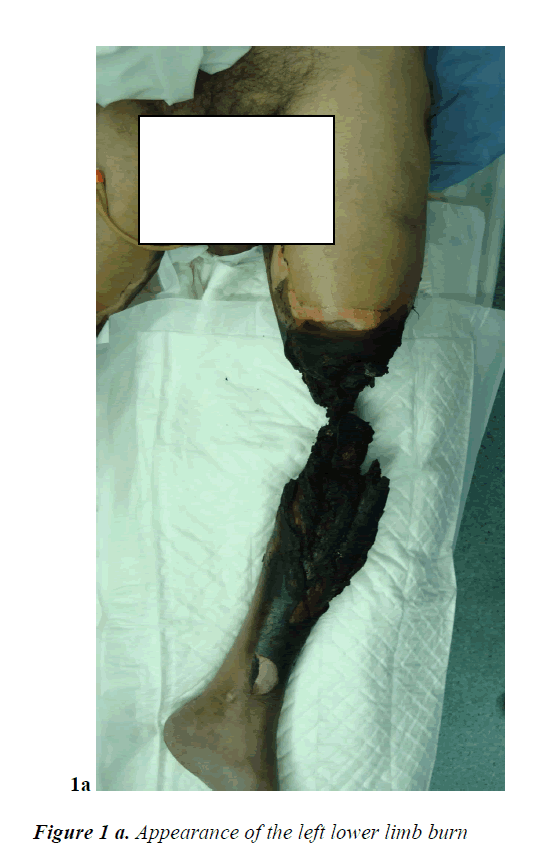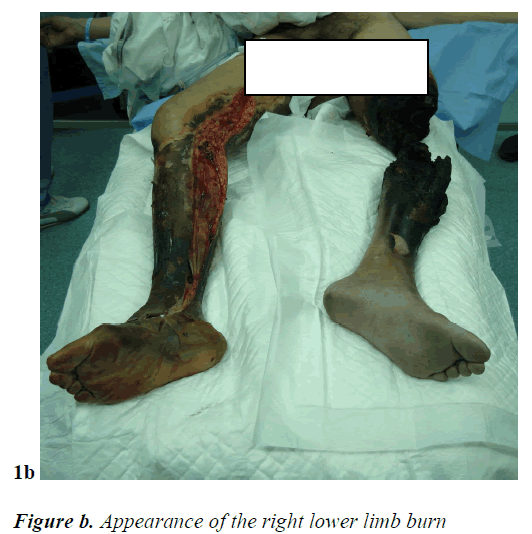- Biomedical Research (2014) Volume 25, Issue 4
Contact charcoal burn associated with acute central cord syndrome.
Abdullah Al-Thunyan, Mohammad M. Al-Qattan*, Hanan Al-Husainan, Obaid Al-MeshalFrom the Division of Plastic Surgery, King Fahad National Guard Hospital and the Division of Plastic Surgery at King Saud University, Riyadh, Saudi Arabia
Accepted date: June 02 2014
Abstract
We describe a very unusual contact charcoal burn associated with acute central cord syndrome. The patient is a known case of cervical degenerative disc disease who accidentally slipped and fell down in hot charcoal with sudden neck hyperextension. This lead to acute central cord syndrome, quadriplegia, loss of sensation, and bilateral lower limb 4th degree burn requiring amputation. The case is reported to increase the awareness of burn surgeons to burns associated with central cord syndrome.
Keywords
Burn, Charcoal, Central cord syndrome
Introduction
Contact charcoal burn is a well known entity and has been reported to occur by three mechanisms. Recreational activities (especially on the beach) frequently have “fire pits” with hot charcoal. Both children and intoxicated adults can fall into these “fire pits” sustaining deep burns involving different parts of the body [1,2]. Camp-fires while camping in the desert is also a common practice by families on weekends in Saudi Arabia. Crawling infants into the hot charcoal sustain deep burns of the palms [3]. In the Far-East, "burning charcoal" in an enclosed space is a common method of committing suicide. When the suicide is unsuccessful, the unconscious patient may fall on the hot charcoal resulting in a localized deep burn that frequently requires primary free flap coverage [4,5]. In this paper, we describe a very unusual charcoal burn associated with acute central cord syndrome.
Case report
Our patient is a 72-year old male who is known case of cervical degenerative disc disease. He was camping alone in the desert and put up a charcoal fire inside his tent. He accidentally slipped and fell down with sudden neck hyperextension. The left leg was in contact with the charcoal and the right leg was adjacent to the charcoal. Neck hyperextension led to acute central cord syndrome with quadriplegia and loss of sensation of the limbs. He was fully awake but was unable to move his insensate legs away. His friends came by five hours later, and immediately took him to the hospital. On presentation to our emergency department, the left leg was burnt to ashes (Fig 1a). The right leg had fourth degree burns with a devascularized foot. Right leg fasciotomy was done in the emergency room and showed necrotic muscles (Fig 1b). The posterior aspect of both thighs and the perineum also had third degree burns from contact to the hot sand. Neurological examination showed a fully conscious man with quadriplegia and complete loss of sensation. There was also urinary retention. An MRI showed diffuse cervical degenerative disease with a spondylotic disc osteophyte complex and hyperintense signal of the spinal cord. There was no significant spinal canal stenosis and there were no fractures. The clinical and radiological findings were consistent with acute central cord syndrome and our neurosurgeon elected for conservative management. The patient underwent left above-knee amputation and right below-knee amputation. The posterior aspect of the thighs and perineum required tangentional excision and skin grafting, and there was full skin graft take. Starting on the second day after injury, the neurological status of the patient gradually improved. The patient regained urine and fecal continence. Sensory recovery of the upper limbs was complete with normal 2-point discrimination of all digits. The motor recovery, however, was incomplete. The upper limb motor power was graded as 4 out of 5 (active motion against resistance) by the Medical Research Council (MRC) scale for muscle strength. The motor power of both hips and the right knee were complete and were graded as 5 out of 5 by the MRC scale. The patient is now 6 months after injury and is able to live independently with a wheelchair.
Discussion
Our literature review did not reveal any burn cases directly related to acute central cord compression syndrome. The syndrome was first described by Schneider et al. [6] in 1954. It is commonly seen in the elderly with degenerative cervical disc disease. A sudden hyperextension of the neck in these patients results in acute central cord compression by the spondylotic disc osteophyte complex [7]. The central cord syndrome presents as a spectrum, from weakness limited to the upper limbs with sensory preservation, to quadriplegia and complete loss of sensation. Most patients recover well with conservative management and surgery is indicated only in patients with significant spinal canal stenosis or spinal instability. Our patient had severe acute symptoms and recovered well although sensory recovery was better than motor recovery, and motor recovery of lower limbs was better than motor recovery of the upper limbs. The reason for the relative sensory preservation and the relative motor preservation of the lower limbs is thought to be related to the development of a "central" intraparenchymal spinal cord hematoma leading to injury to the decussating corticospinal tracts [7].
“Fourth degree" burn is a term that is occasionally used to describe lower limb burns with exposed tendon and bone [8]. The burn degree of the left leg in our patient was even deeper with the injured area turning into ashes at the scene (Fig 1a). The prolonged contact to charcoal explains the severity of the burn injury in the left leg. In contrast, the prolonged contact to the hot sand explains the burns in other areas.
In conclusion, we report a very unusual case of charcoal contact burn associated with central spinal cord syndrome to increase the awareness of burn surgeons to this mechanism of injury.
Disclosure
There is no conflict of interest
Funding
The work was funded by the College of Medicine Research Center, Deanship of Scientific Research, King Saud University, Riyadh, Saudi Arabia.
References
- Cahill TJ, Rode H, Millar AJW. Ashes to ashes: Thermal contact burns in children caused by recreational fires. Burns 2008; 34:12153-12157.
- Fraga AMA, Fraga GP, Noordenbous J, Tenenhaus M, Castle S, Bhavsar D, Lee JG, Coimbra R, Potenza BM. Beach and campfire Burns: A site of pleasure and tragedy. J Burn Care Res 2010; 31: 184-189.
- Al-Qattan MM. Campfire burns of the palms in crawling infants in Saudi Arabia: Results following release and graft of contractures. J Burn Care Res 2009; 30: 6161-6169.
- Chou TD, Lee WT, Chen SL, Chen TM, Lee CH, Wang HJ. The management of complicated charcoal contact burns involving deep tissues. Burns 2004; 30:746-750.
- Burd A, Ahmed K, Noronha FV, Chan JYW, Pang PCW. Surgical reconstruction of attempted suicide charcoal burns. J Burn Care Res 2006; 27:330-332.
- Schneider RC, Cherry G, Pantek H. The syndrome of acute central cervical spinal cord injury, with special reference to the mechanisms involved in hyperextension injuries of cervical spine. J Neurosurg 1954; 11: 546-577.
- Harrop JS, Sharan A, Ratliff J. Central cord injury: pathophysiological, management and outcomes. Spine J 2006; 6: S198-S 206.
- Parrett BM, Pomatrac B, Demling RH, Orgill DP. Fourth-degree burns to the lower extremity with exposed tendon and bone: A ten-year experience. J Burn Care Res 2006; 27: 34-39.

